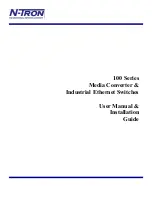
Publication date: Mar. 2016
33600 Rev B
28
Frame Reception
In essence, the frame reception is the same in both operations of half duplex
and full duplex, except that full-duplex operation uses two buffers to transmit and
receive the frame independently. The receiving node always “listens” if there is
traffic running over the medium when it is not receiving a frame. When a frame
destined for the target device comes, the receiver of the target device begins
receiving the bit stream, and looks for the PRE (Preamble) pattern and Start-of-
Frame Delimiter (SFD) that indicates the next bit is the starting point of the MAC
frame until all bit of the frame is received.
For a received frame, the MAC will check:
1.
If it is less than one slotTime in length, i.e. short packet, and if yes, it
will be discarded by MAC because, by definition, the valid frame must
be longer than the slotTime. If the length of the frame is less than one
slotTime, it means there may be a collision happened somewhere or
an interface malfunctioned in the LAN. When detecting the case, the
MAC drops the packet and goes back to the ready state.
2.
If the DA of the received frame exactly matches the physical address
that the receiving MAC owns or the multicast address designated to
recognize. If not, discards it and the MAC passes the frame to its client
and goes back to the ready state.
3.
If the frame is too long. If yes, throws it away and reports frame Too
Long.
4.
If the FCS of the received frame is valid. If not, for 10M and 100M
Ethernet, discards the frame. For Gigabit Ethernet or higher speed
Ethernet, MAC has to check one more field, i.e. extra bit field, if FCS is
invalid. If there is any extra bits existed, which must meet the
specification of IEEE802.3. When both FCS and extra bits are valid,
the received frame will be accepted, otherwise discards the received
frame and reports frameCheckError if no extra bits appended or
alignmentError if extra bits appended.
5.
If the length/type is valid. If not, discards the packet and reports
lengthError.
6.
If all five procedures above are ok, then the MAC treats the frame as
good and de-assembles the frame.
What if a VLAN tagging is applied?
VLAN tagging is a 4-byte long data immediately following the MAC source
address. When tagged VLAN is applied, the Ethernet frame structure will have a
little change shown as follows.
Only two fields, VLAN ID and Tag control information are different in
comparison with the basic Ethernet frame. The rest fields are the same.
The first two bytes is VLAN type ID with the value of 0x8100 indicating the
received frame is tagged VLAN and the next two bytes are Tag Control Information
Содержание SM24TAT4GPA
Страница 2: ......
Страница 6: ......
Страница 12: ...Publication date Mar 2016 33600 Rev B 6 1 4 2 the Rear Panel Fig 1 3 Rear View of SM24TAT4GPA ...
Страница 48: ...Publication date Mar 2016 33600 Rev B 42 Configuration Monitoring Maintenance Root ...
















































